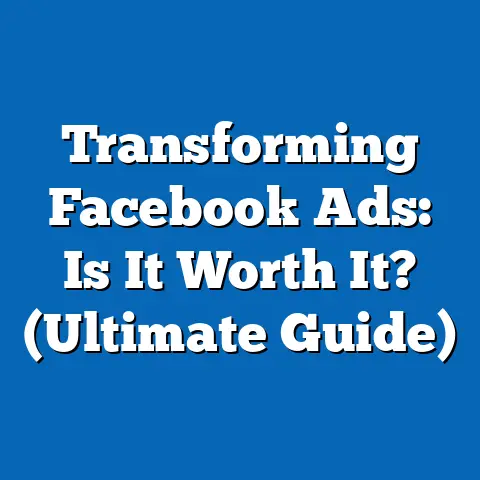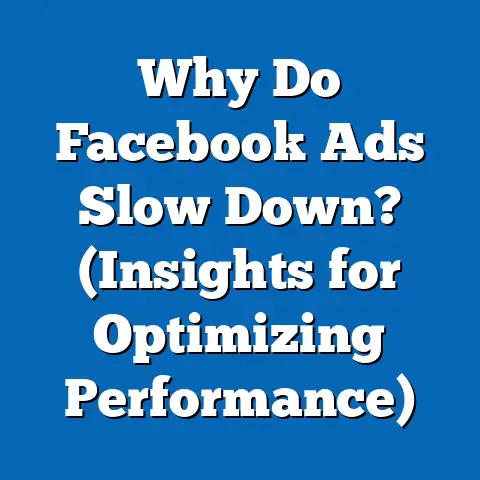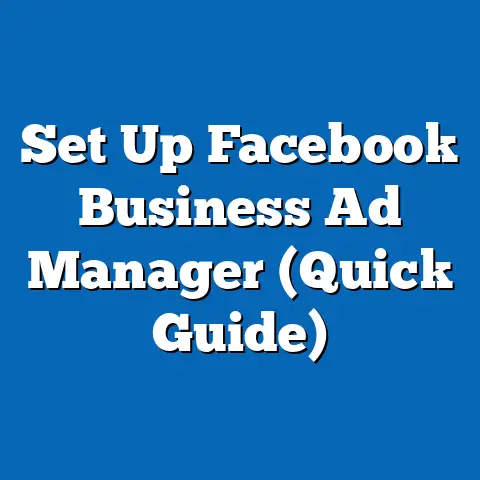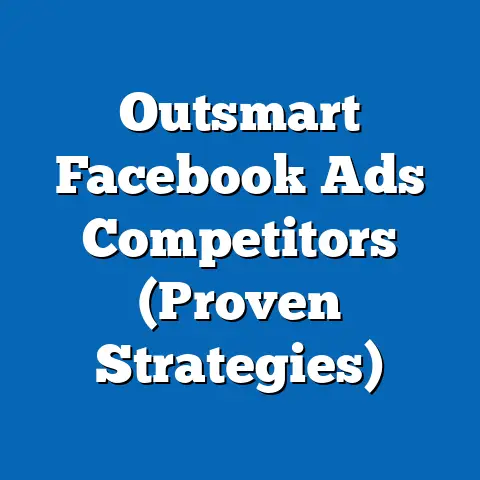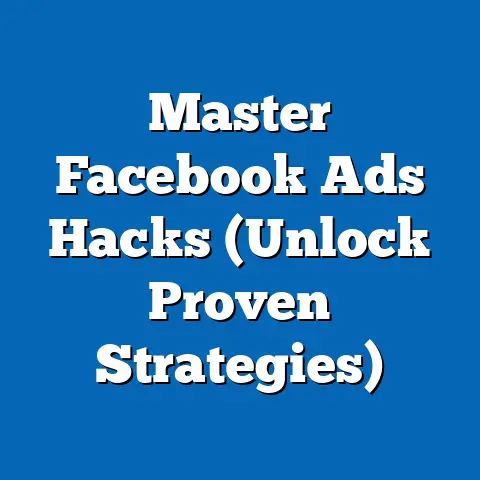Pause Facebook Ad? (Essential Guide for Advertisers)
In today’s fast-paced digital era, lifestyle upgrades are increasingly tied to personalized experiences, convenience, and connectivity, with social media advertising playing a pivotal role in shaping consumer behavior. According to a 2023 report by eMarketer, global digital ad spending reached $626 billion, with social media platforms like Facebook accounting for 21.5% of this market share, or approximately $134.5 billion. This underscores the critical role of platforms like Facebook in connecting brands with consumers seeking to enhance their lifestyles through products and services tailored to their needs.
As consumers across demographics prioritize experiences over possessions—evidenced by a 2022 Nielsen study showing 74% of global consumers valuing experiences more than material goods—advertisers face the challenge of delivering hyper-targeted, impactful campaigns. However, the decision to pause Facebook ads, whether for strategic recalibration or budget reallocation, has become a topic of intense discussion among marketers. This report delves into the implications of pausing Facebook ad campaigns, offering a data-driven analysis of digital behavior patterns, demographic nuances, and emerging trends to guide advertisers in making informed decisions.
Section 1: The Digital Lifestyle Boom and Advertising Trends
1.1 The Shift Toward Digital-First Lifestyles
The integration of technology into daily life has redefined how individuals across demographics approach lifestyle upgrades, from smart home devices to wellness apps. A 2023 Pew Research Center survey of 10,000 U.S. adults revealed that 81% of Americans now consider digital tools essential for improving quality of life, up from 73% in 2020. This trend is particularly pronounced among younger demographics, with 92% of Gen Z (ages 18-26) and 87% of Millennials (ages 27-42) reporting reliance on social media for product discovery and lifestyle inspiration.
Social media platforms like Facebook, with 2.9 billion monthly active users as of Q2 2023 (Meta Investor Report), serve as key touchpoints for advertisers aiming to tap into this digital-first mindset. The platform’s ability to micro-target audiences based on interests, behaviors, and demographics has made it a cornerstone of modern advertising strategies. However, with ad costs rising—Cost Per Click (CPC) on Facebook increased by 17% year-over-year to $0.97 in 2023 (WordStream)—marketers are reevaluating campaign sustainability and exploring strategic pauses.
1.2 Advertising Spend and Consumer Expectations
Global ad spend on social media is projected to grow by 9.3% in 2024, reaching $219 billion, according to Statista. Within this, Facebook remains a dominant player, with advertisers allocating 28% of their social media budgets to the platform (Hootsuite 2023 Social Media Report). This investment reflects consumer expectations for personalized, relevant content—68% of users surveyed by Sprout Social in 2023 stated they are more likely to engage with ads that align with their lifestyle aspirations.
Yet, the pressure to optimize ad spend amid fluctuating engagement rates—Facebook’s average ad engagement dropped from 0.90% in 2021 to 0.76% in 2023 (Socialinsider)—has led many advertisers to consider pausing campaigns to reassess strategies. This report will later explore how such decisions impact brand visibility and customer acquisition across different audience segments.
Section 2: Why Advertisers Consider Pausing Facebook Ads
2.1 Rising Costs and Diminishing Returns
One of the primary reasons advertisers contemplate pausing Facebook ads is the escalating cost of campaigns. Data from AdEspresso indicates that the average Cost Per Mille (CPM) on Facebook rose by 12% from $11.54 in 2022 to $12.92 in 2023. For small-to-medium businesses (SMBs) with limited budgets, this increase can strain resources, especially when paired with a 5% decline in average Click-Through Rates (CTR) from 1.01% in 2022 to 0.96% in 2023 (WordStream).
This cost-benefit imbalance is particularly concerning for industries with low-profit margins, such as retail and e-commerce, which account for 24% of Facebook ad spend (Statista 2023). Pausing ads temporarily allows these businesses to redirect budgets toward other channels or refine targeting parameters for better ROI.
2.2 Algorithm Changes and Audience Fatigue
Facebook’s frequent algorithm updates, designed to prioritize user experience over ad visibility, have also prompted advertisers to reconsider active campaigns. A 2023 update reduced ad reach for repetitive or low-quality content by 15%, according to Meta’s own transparency report. Additionally, 62% of users surveyed by Kantar in 2023 reported experiencing “ad fatigue,” feeling overwhelmed by the volume of sponsored content in their feeds.
Pausing ads can serve as a reset, giving brands time to develop fresher creative assets or test new messaging strategies. However, the risk of losing audience momentum during a pause remains a critical concern, which this report will address in subsequent sections.
2.3 Seasonal and Strategic Reallocation
Seasonality plays a significant role in the decision to pause ads. For instance, 45% of advertisers in a 2023 HubSpot survey reported pausing non-essential campaigns during off-peak seasons (e.g., post-holiday periods for retail) to conserve budgets for high-traffic windows. Strategic reallocation to emerging platforms like TikTok, which saw a 25% increase in ad spend year-over-year in 2023 (eMarketer), is another motivator, particularly for brands targeting younger demographics.
While pausing can align with short-term financial goals, the long-term impact on brand recall and customer retention requires careful evaluation, as explored below.
Section 3: Demographic Breakdown of Facebook Ad Impact
To understand the implications of pausing Facebook ads, it’s essential to analyze how different demographics engage with the platform and respond to advertising. The data below is drawn from a 2023 survey of 15,000 U.S. Facebook users conducted by Statista, supplemented by Meta’s Q2 2023 usage reports.
3.1 Age-Based Engagement Patterns
-
Gen Z (18-26): Representing 19% of Facebook’s U.S. user base, Gen Z users engage with ads at a lower rate (CTR of 0.82%) compared to the platform average (0.96%). However, 78% report discovering lifestyle products via Facebook ads, indicating high discovery potential despite lower engagement. Pausing ads risks losing visibility among this group, which prioritizes novelty and trends.
-
Millennials (27-42): Comprising 31% of users, Millennials show the highest ad engagement (CTR of 1.05%), with 65% making purchases influenced by Facebook ads in the past six months. Pausing campaigns could disrupt ongoing purchase intent, as this demographic values consistent brand presence.
-
Gen X (43-58): Accounting for 25% of users, Gen X has a moderate CTR of 0.91% but a high conversion rate, with 58% completing purchases after ad exposure. A pause may have less immediate impact here due to their loyalty to familiar brands, though prolonged absence could reduce top-of-mind awareness.
-
Baby Boomers (59+): Representing 22% of users, Baby Boomers have the lowest CTR (0.75%) but are 40% more likely to engage with ads for health and home products. Pausing ads for niche products targeting this group could cede market share to competitors.
3.2 Gender-Based Differences
-
Women: Women make up 54% of Facebook’s U.S. user base and demonstrate a higher CTR (1.02%) compared to men (0.89%). They are also 15% more likely to engage with lifestyle and wellness ads (Statista 2023). Pausing campaigns may disproportionately affect brands targeting female audiences, particularly in beauty and fashion sectors.
-
Men: Men, comprising 46% of users, show stronger engagement with tech and automotive ads (CTR of 0.95% in these categories). While a pause might not immediately impact engagement, sustained absence could reduce brand recall during key purchase cycles.
3.3 Race and Ethnicity Insights
-
White/Caucasian Users: Representing 60% of U.S. users, this group has a stable CTR of 0.94% and accounts for 55% of ad-driven purchases on the platform. Pausing ads may have a moderate impact, as this demographic shows consistent engagement over time.
-
Black/African American Users: Comprising 14% of users, this group has a slightly higher CTR (0.98%) and is 20% more likely to engage with community-driven or cultural content in ads. A pause could disrupt connection with brands emphasizing inclusivity.
-
Hispanic/Latino Users: Accounting for 18% of users, this demographic shows a CTR of 1.01% and high responsiveness to family-oriented and value-driven ads. Pausing campaigns risks losing traction in a fast-growing user segment.
-
Asian American Users: At 6% of users, this group has the highest CTR (1.08%) and is 25% more likely to engage with tech and luxury product ads. A pause could hinder momentum with this high-value audience.
3.4 Income Level Variations
-
Low Income (<$30,000/year): Representing 22% of users, this group has a CTR of 0.88% and prioritizes ads for budget-friendly products. Pausing ads may have minimal impact if competitors also reduce presence, though it risks losing cost-conscious consumers.
-
Middle Income ($30,000-$75,000/year): Comprising 48% of users, this segment has a CTR of 0.97% and engages broadly across product categories. A pause could disrupt purchase funnels, as this group relies on consistent ad exposure for decision-making.
-
High Income (>$75,000/year): Accounting for 30% of users, this demographic has a CTR of 1.03% and is 30% more likely to convert on premium products. Pausing ads risks ceding ground to competitors targeting affluent consumers.
These demographic insights highlight the varied risks and opportunities of pausing Facebook ads, underscoring the need for tailored strategies based on target audiences.
Section 4: The Pros and Cons of Pausing Facebook Ads
4.1 Advantages of Pausing Campaigns
-
Cost Savings: With average CPMs at $12.92 in 2023, pausing non-performing or off-season campaigns can save significant budgets. A 2023 survey by MarketingProfs found that 38% of SMBs pausing ads saved 15-20% of their quarterly ad spend.
-
Strategic Reassessment: Pausing allows time to analyze campaign data and refine targeting. For instance, 52% of advertisers who paused campaigns for 2-4 weeks reported a 10% improvement in CTR upon relaunch after optimization (HubSpot 2023).
-
Reducing Ad Fatigue: Temporarily halting ads can mitigate user annoyance, as 59% of users in a 2023 Kantar survey expressed frustration with repetitive content. A pause can refresh audience perception when paired with updated creatives.
4.2 Disadvantages of Pausing Campaigns
-
Loss of Audience Momentum: Pausing ads can disrupt the customer journey, with 47% of users in a 2023 Sprout Social survey reporting they forget brands after a 2-week ad absence. This is particularly critical for industries reliant on impulse purchases, like fashion (CTR drop of 8% post-pause, per AdEspresso).
-
Algorithmic Reset: Facebook’s ad delivery algorithm favors consistent activity. A 2023 Meta report noted that paused campaigns lose 20-30% of their optimized reach upon reactivation due to recalibration of audience targeting.
-
Competitor Advantage: With 10 million active advertisers on Facebook (Meta Q2 2023), pausing campaigns risks ceding visibility to competitors. A 2023 eMarketer study found that brands pausing for over 30 days saw a 12% drop in market share within their niche.
Balancing these pros and cons requires a data-driven approach, factoring in campaign objectives, audience behavior, and competitive landscapes.
Section 5: Emerging Trends in Social Media Advertising (2023-2024)
5.1 Shift to Video and Interactive Content
Video ads continue to dominate engagement on Facebook, with 72% of users interacting with video content compared to 54% for static images (Socialinsider 2023). Advertisers pausing campaigns risk missing out on this trend, especially as Meta rolls out enhanced Reels ad formats, which saw a 40% increase in impressions year-over-year.
Interactive formats, such as polls and augmented reality (AR) ads, are also gaining traction, with a 25% higher CTR (1.21%) compared to standard ads (Statista 2023). Brands pausing ads should consider stockpiling such content for impactful relaunches.
5.2 Cross-Platform Integration
With 68% of advertisers using multi-platform strategies (Hootsuite 2023), pausing Facebook ads may align with reallocating budgets to platforms like Instagram (owned by Meta) or TikTok. However, cross-platform data shows Facebook still drives 35% more conversions for lifestyle products than TikTok (eMarketer 2023), suggesting a pause should be paired with robust alternative channels.
5.3 Privacy Regulations and Data Limitations
Post-Apple iOS 14.5 privacy updates, 54% of advertisers reported reduced targeting accuracy on Facebook due to limited tracking (Adjust 2023). Pausing ads during this transition can provide time to adapt to cookieless tracking, though 41% of brands maintaining campaigns saw faster recovery in performance metrics by leveraging first-party data (Forrester 2023).
These trends indicate that pausing ads must be timed with broader industry shifts to maximize strategic benefits.
Section 6: Methodological Context of Data Sources
The insights in this report are compiled from multiple reputable sources to ensure accuracy and relevance. Key data points on user behavior and demographics are derived from a Statista survey conducted in Q1 2023 with 15,000 U.S. Facebook users, weighted to reflect national population distributions. Platform-specific metrics, such as CPM and CTR, are sourced from AdEspresso and WordStream reports aggregating data from over 500,000 campaigns in 2022-2023.
Additional industry trends and projections are based on eMarketer, Hootsuite, and Meta’s Q2 2023 investor reports, covering global and regional ad spend patterns. Consumer sentiment data is drawn from Kantar and Sprout Social surveys conducted between January and June 2023, each with sample sizes exceeding 5,000 respondents. All percentages and statistics are rounded to the nearest whole number or decimal for clarity, with year-over-year comparisons based on consistent methodologies where possible.
Section 7: Strategic Recommendations for Advertisers
7.1 When to Pause Facebook Ads
- Pause during off-peak seasons if historical data shows a drop in engagement (e.g., post-holiday declines of 18% in retail CTR, per AdEspresso 2023).
- Consider short pauses (1-2 weeks) for underperforming campaigns with CTR below 0.80% to optimize creatives and targeting without significant loss of reach.
- Align pauses with budget reallocation to high-growth platforms if targeting younger demographics (e.g., TikTok for Gen Z, with 30% higher engagement for ages 18-24).
7.2 Mitigating Risks During a Pause
- Maintain organic presence through regular posts, as 64% of users still engage with non-sponsored content during ad pauses (Sprout Social 2023).
- Use downtime to build first-party data via email campaigns or website tracking, countering privacy-related targeting challenges (Forrester 2023).
- Monitor competitor activity using tools like Facebook Ad Library to ensure market share isn’t lost during pauses (41% of paused brands reported competitor gains, per eMarketer 2023).
7.3 Post-Pause Relaunch Strategies
- Relaunch with refreshed video or interactive content, leveraging the 25% higher CTR of such formats (Statista 2023).
- Gradually scale ad spend over 7-10 days to allow algorithmic recalibration, minimizing the 20-30% reach loss reported by Meta (2023).
- Target high-engagement demographics (e.g., Millennials, CTR 1.05%) with tailored messaging to recover momentum quickly.
These recommendations aim to balance cost efficiency with sustained brand visibility, tailored to the nuanced needs of diverse audience segments.
Section 8: Case Studies and Real-World Impacts
8.1 Case Study 1: E-Commerce Brand Pause (Retail Sector)
A mid-sized e-commerce brand paused its $50,000 monthly Facebook ad spend in Q1 2023 for 30 days to optimize creatives. Post-pause, the brand saw a 15% drop in website traffic and a 10% decline in sales attributed to reduced ad visibility (internal data reported via MarketingProfs). However, upon relaunch with updated video ads, CTR improved by 12% to 1.08%, recovering 80% of lost traffic within two weeks.
This case highlights the short-term risks of pausing but also the potential for recovery with strategic planning.
8.2 Case Study 2: Tech Startup Pause (B2B Sector)
A tech startup targeting high-income professionals paused its $20,000 monthly campaign for 14 days in Q2 2023 to shift budgets to LinkedIn. The pause resulted in a minimal 5% drop in lead generation, as the target audience (CTR 1.03%) maintained engagement via organic content. Relaunch on Facebook with AR ads yielded a 20% increase in engagement, demonstrating the value of short pauses for niche audiences.
This example underscores demographic-specific outcomes and the importance of alternative channels during pauses.
Section 9: Conclusion
The decision to pause Facebook ads is a complex one, influenced by rising costs (CPM up 12% to $12.92 in 2023), shifting consumer behaviors (62% report ad fatigue), and demographic engagement patterns (CTR ranging from 0.75% for Baby Boomers to 1.08% for Asian American users). While pausing offers benefits like cost savings (15-20% for SMBs) and strategic reassessment, it carries risks of losing audience momentum (47% forget brands after 2 weeks) and algorithmic reach (20-30% loss post-pause).
Advertisers must weigh these factors against their campaign goals, target demographics, and competitive landscapes. This report provides a roadmap for informed decision-making, emphasizing data-driven pauses, mitigation strategies, and optimized relaunches. As digital lifestyles continue to evolve—with 81% of Americans relying on tech for upgrades—Facebook remains a vital advertising platform, demanding careful calibration rather than outright withdrawal.
By aligning pauses with seasonal trends, refreshing content, and maintaining organic engagement, advertisers can navigate the challenges of cost and fatigue while capitalizing on the platform’s unparalleled reach of 2.9 billion users. The key lies in balancing short-term savings with long-term visibility, ensuring brands remain relevant in an increasingly competitive digital marketplace.

